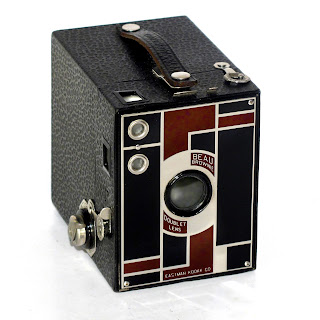17.
SOME
MORE BROWNIES FOUND
The Kodak Brownie Box-cameras were produced from 1900 to 1957.
Apart from the design and a flash contact, it was the same simple box as always.
Apart from the design and a flash contact, it was the same simple box as always.
From the commonly used Kodak 620 film you got pictures size 6x9 cm.
Slightly bigger pictures got popular in USA by using the 616 film.
In my view that improvement from 6x9 to 6,5x11 cm format was hardly significant.
 |
Over the years the exteriors changed
in colours and patterns according to
|
Already in 1901 Kodak realized that the Box-cameras were a bit clumsy.
Most of the forerunners had bellows to achieve a good focusing. To mimic a more professional camera, a "Brownie Folding" were made too, but in a bit simpler version. Not that inexpensive as the boxes though.
A cheaper version were made in 1937. It looked well, but had the same performance as the eldest boxes. That is "fix-focus" and only one shutter-speed (I) unless you had a good tripod and solid knowledge of measuring light and time determination (B).
The main problem with Brownie-boxes was the "fix-focus", that meant a lack of focus closer to the camera than 2 meters. So the german factory invented a built in Portrait-lens that could be used for "close ups" between 1 and 2 meters.
Kodak cameras were made in many countries and in all sorts of design, inventions and constructions.
But I am not aware of any trademark as long lived as
Brownie.























































